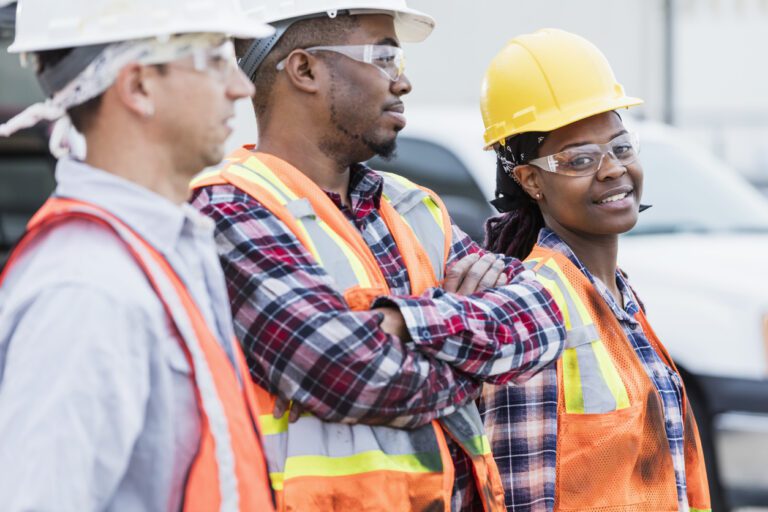Despite growth in the building and infrastructure sector, a global labor shortage continues to plague the construction industry. Moreover, experienced workers are starting to enter retirement age, meaning the sector is losing some of its most skilled laborers and leaders. As recruiting and retaining talent remain significant challenges, the sector must dig deeper to solve its labor problem.
A panel of construction leaders spoke at Procore’s Groundbreak 2022 conference about how one of the key strategies in addressing the labor shortage is recognizing the value and importance of a diverse workforce. If the industry fails to recognize the need for diversity and inclusion, it will continue to miss out on many talented workers and opportunities.
“The construction industry has gotten away with not looking like the country,” says Jennifer Todd, the president and founder of LMS General Contractors. “To get ahead in this industry, we have to go to the people that we haven’t been going to, which are people of color and women, in order to fill the labor shortage.”
Despite the potential for career development and growth, women and minority groups still face significant barriers to entry and advancement in the construction industry. Inclusion remains a critical issue, as many underrepresented workers report feeling unwelcome and unvalued.
The Construction Progress Coalition surveyed nearly 300 industry professionals in October 2022 to determine why some are leaving the industry. Executive director Michael Hazelwood and his team overwhelmingly found that a lack of inclusivity was the primary reason qualified workers chose to change industries.
“The feeling of ‘I do not belong here’ was powerful, with women at the top of that finding, alongside LGBTQIA + members,” says Hazelwood. “However, for men, this reason was at the very bottom. This basically means that there is a total disconnect between how women and people of color view the industry versus others today.”
Thankfully, there is room for everyone in construction. The industry offers an incredible array of opportunities, from skilled labor and project management to environmental impact studies and architectural design.
Moreover, the gender pay gap is nearly non-existent. Women in construction earn 99.1% compared to their male counterparts; in other professions in the US, women take home only 84% of what men make. Addressing today’s labor shortage can provide mutual benefits for companies and potential employees. In order to attract qualified candidates, construction businesses must create a more inclusive work environment where everyone feels valued.
Get Proactive and Find Your Own Workforce
Recruiting and retaining talent from underrepresented demographics requires proactive measures. Instead of waiting for diverse candidates to magically appear and apply, companies should invest in training programs, summer camps, mentorships and apprenticeships that bring in talent from various sources.
Angie Simon, an advisor to the Board of Western Allied Mechanical, realized there was a gap in skilled trade training for young people. In response, she’s created the Heavy Metal Summer Experience, a nonprofit organization that successfully teaches adolescents how to work with sheet metal piping. Growing from only 28 students, the Heavy Metal Summer Experience now hosts 425 students across 30 locations.
Construction leaders must step up and invest in their future employees.
“My challenge to contractors is to stop asking everyone else to find your future workforce. Start taking action and looking at yourself to do that,” says Simon.
By engaging in community outreach initiatives, construction companies can create opportunities that bring more workers into the industry.
How the industry markets itself is another key piece of attracting outside talent. Many still hold outdated views of the industry, associating it solely with manual labor and old-fashioned attitudes, which may keep some talented recruits away.
“I think the industry has an identity problem,” says Heather Collins, EVP of People and IT for EMJ Corporation. She believes that perception is a crucial issue keeping workers from entering the industry.
“First of all, people don’t always consider it to be a viable or ‘cool’ career. Did you ever say to your kids, ‘Hey, when you finish high school, why not go into construction?’”
The industry has evolved with time and new tech, opening up more opportunities for all kinds of people. While physical work is undoubtedly a part of the industry, there are numerous other roles requiring unique skills and qualifications. Recruiting managers need to showcase how many diverse career options are available to start attracting non-traditional talent.
Encourage Career Growth
Providing support throughout the entire career journey, from apprenticeships to hiring and beyond, is vital to retain talent long-term. As such, creating mentorship programs is another essential for encouraging growth within the industry.
“It’s not just about creating jobs,” says Todd. “It’s about changing individuals’ lives and giving them the foundation to work for larger companies.”
As part of that objective, companies also need to offer more flexible schedules, competitive maternity leave options and, yes, more paid time off. These work-life balance initiatives are crucial in creating a supportive and accommodating workplace culture and are necessary if companies want to retain their best and brightest.
To truly embrace diversity and inclusion, construction companies must be willing to challenge the status quo. This isn’t always easy for industry leaders, especially those more accustomed to conventional recruitment practices. F
For Collins, this meant making tough calls about partnerships and management promotions.
“If we have individuals who are not being inclusive and respectful, we have to be OK to part company with some of those individuals,” she says. “You have to work differently, but for an organization, it can be necessary to move the company forward.”
Embracing change and fostering a culture that values diversity and inclusion builds a more dynamic and innovative industry and a wider talent pool. The construction industry needs to take proactive steps toward creating a more diverse workforce if it wants to help find a solution to today’s labor shortage crisis.

Leave a Reply